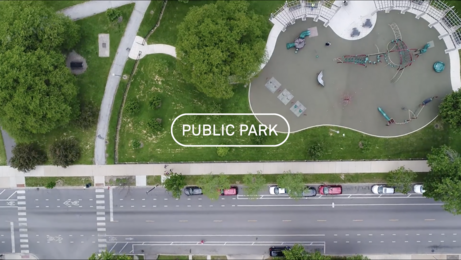Madlener House
4 West Burton Place
Chicago, Illinois 60610
Telephone: 312.787.4071
info@grahamfoundation.org

Considering the Chicago Park District network as a platform for cultural life and civic activation that is a unique network of public spaces, this participatory conversation raises questions about the significance, maintenance, and relevance of these civic spaces. With more than 600 parks, 400 field houses, 26 miles of lakefront, 50 outdoor pools, a museum campus, and Soldier Field, today’s Park District operates as a sovereign territory within the city. Multiple and distributed, this territory pervades every ward and neighborhood. Fieldwork asks local and global questions around “publicness”—the complex patterns of individuals and communities, and the systems that organize them. As a network of sites, each park is a polyvalent territory, at once natural, social, psychological, ecological, political, ethnic, historic, and economic. With cultural change, the distribution and structure of the park network faces new demands, and so does the very mythology that grounds it. If these parks were emblematic of Chicago as a city defined by modern industry, later additions to the system—such as Millennium Park—are emblematic of Chicago’s shift to finance, culture, tourism, and lifestyle economies.Through this discussion Fieldwork explores what opportunities emerge if we radically rethink Chicago’s parks.
Fieldwork Collaborative Projects is an interdisciplinary nonprofit dedicated to increasing cultural activity in the Chicago region. Established by artists with backgrounds in architecture, urban planning, anthropology, research, and criticism, the group has extensive experience with curatorial work and institutional administration. By working beyond the confines of the museum or gallery, Fieldwork transforms underutilized spaces traditionally used for sport or recreation by organizing performances, exhibitions, or other unexpected activities to expose the unseen, unconsidered, underestimated or overlooked potential of a particular place.
Nelly Agassi works in performance, installation, video, textile and paper. Her artwork addresses the idea of the body and notion of intimacy within public space in relation to architecture. Her work engages both the personal and emotional as well as universal concepts. Agassi is a 2001 graduate of the MA program of combined media in Chelsea College of Art and Design, London, UK. She has received the Nathan Gottesdiener Foundation for Israeli Art Prize and the Tel Aviv Museum of Art award for artistic encouragement from the Israel Ministry of Science, Culture and Sport. Agassi shown her work extensively throughout the world – in sites such as the Israel Museum, Doritto Rovesscio, Milan Triennial, Poor Farm, USA, Hyde Park Art Center, USA, Terrain Biannial, USA and at the Tate Modern in London.
Ionit Behar is an art historian, curator and critic. She is a Ph.D. candidate in Art History at the University of Illinois at Chicago. Her interests are focused on 20th century Latin American and North American art, the history of exhibitions, sculpture after 1960, and theories of space and place. Behar is interested in the relation between the academic discipline of art history and the practice of museum curating. She holds a Master’s degree in Art History, Theory and Criticism from the School of the Art Institute of Chicago, a Bachelor of Art Theory from Tel Aviv University, and a degree in Art Administration from the Bank Boston Foundation in Montevideo. She is the Curator of Collections and Exhibitions at Spertus Institute for Jewish Learning and Leadership and the Director of Curatorial Affairs for Fieldwork Collaborative Projects NFP (FIELDWORK).
Merav Argov is a graduate of the University of Illinois at Chicago (UIC) in the Urban Planning and Policy Department. She received her Bachelor of Fine Art degree in 1997 from Bezalel Academy of Art and Design, Jerusalem, Israel. She has participated in civic planning and programing in Jerusalem, Tel-Aviv, Jaffa, Amsterdam and Chicago, with insight into urban planning, art installations as well as programing and spatial enterprises. Along with art and environment planning and consultancy, she has worked at Bezalel Public Advocates in Jerusalem, and with the Arabic-Jewish organization for co-existence and democracy in Jaffa. Her works are shown at the Rosenthal Museum in Germany. Argov’s work dealing with the relation between people and their environment has been reviewed and featured in the Haaretz Magazine.
Andrew Schachman designs environments, infrastructures, and installations. He is the executive co-director of two organizations that are experimental spaces for delivering arts and culture within existing metropolitan networks: Floating Museum and Fieldwork Collaborative Projects. Trained as an architect, he designed and managed projects for the offices of Zaha Hadid, Perkins and Will, Carol Ross Barney, and Doug Garofalo. His projects have received numerous awards including the Distinguished Building Award from the American Institute of Architects and the Richard H. Driehaus Foundation Award for Architectural Excellence in Community Design. Principal of Studio Andrew Schachman, he recently completed the design for the Palais de Tokyo’s exhibition, “Singing Stones,” in the roundhouse of the DuSable Museum of African American History. Andrew is a Studio Associate Professor in the College of Architecture at the Illinois Institute of Technology.
For more information on the exhibition, Tatiana Bilbao Estudio: Unraveling Modern Living, click here.
Copyright © 2008–2025 Graham Foundation. All rights reserved.